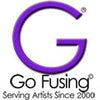
How to Fuse Glass and Metals
How to use Metal in Glass Fusing
How to use Metals in Glass Fusing often is simply Hi temp wire to hang glass or jewelry but it is a very large and diversified topic. In this tips and tricks article for fused glass, we are attempting to provide you with the basic important foundation information so that you will not have to do a lot of test firing and waste your glass.
Important details when fusing metals with glass:
A. Glass and metals are two very different materials and thus have two different rates of expansion. It is important to know the COE of your glass and rates of expansion. Our How To on Determining Glass Compatibility is a great start to understanding each different glass COE (Coefficients of expansion).
B. Annealing your glass when any metals are fused with glass is a MUST! The general rule is that smaller pieces of metal and glass need less annealing. The larger the glass thickness and the larger amounts of metals, the slower and longer the annealing schedule needs to be.
C. Find out if the metal is a pure metal like Brass, Copper, etc. or if it is an alloy, which is a mix of different metals. Alloys can vary widely and can significantly change the expected results when fusing between glass. We sell a full line of jewelry size metal inclusions that are test fired for you so you do not have to worry about metal content and we also offer metal wire and sheets in copper and brass to give you freedom of design. Make sure you also read our Tips and Tricks on How To Fuse Glass Metal Inclusions into your fused glass.
D. Cleaning of the glass on all sides and of the metals prior to firing them together is always recommended. This prevents other chemicals and/or factors such as machine or human oils getting on the metals and glass.
E. Determine your fused glass projects weight. When using the metal as a hanger or connecting piece this will allow you to know what size metal wire, etc. you need to support the art piece.
F. Know the melting point of the metal (see chart below) that you want to incorporate. This will also allow you to compare this to the needed firing schedule to kiln fire your glass project to the form desired. See our Tips and Tricks on Basic Fused Glass Firing Schedules.
Metals used for Fused Glass Inclusions and their Melting temperatures:| Metal | COE of Metal | Melting Point °F | Melting Point °C |
| Aluminum | 248 | 1218 | 659 |
| Brass | 212 | 1050 | 900 |
| Copper | 176 | 1981 | 1081 |
| Gold | 110 | 1915 | 1061 |
| *Cast Iron | 108 | 2300 | 1200 |
| *Lead | 295 | 621 | 320 |
| Silver | 191 | 1764 | 962 |
| Steel (High Carbon) | 121 | 2500 | 1374 |
| Steel (Stainless) | 171 | 2600-2750 | 1430-1507 |
| *Tin | 398 | 788 | 415 |
- Choosing a selection results in a full page refresh.
Newsletter
Quick links
Our mission
Promote the Future of Custom Art Glass by providing inspiration thru sharing creativity and knowledge.
Contact Us
Follow us
!
